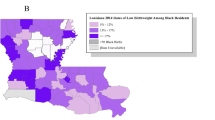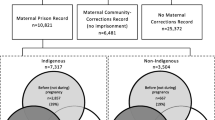Abstract
This study examined the relationships between jail incarceration during pregnancy and infant birth weight, preterm birth, and fetal growth restriction. We used multivariate regression analyses to compare outcomes for 496 births to women who were in jail for part of pregnancy with 4,960 Medicaid-funded births as matched community controls. After adjusting for potential confounding variables, the relationship between jail incarceration and birth outcomes was modified by maternal age. Relative to controls, women incarcerated during pregnancy had progressively higher odds of low birth weight and preterm birth through age 39 years; conversely, jail detainees older than 39 years were less likely than controls to experience low birth weight or preterm birth. For women in jail at all ages, postrelease maternity case management was associated with decreased odds of low birth weight, whereas prenatal care was associated with decreased odds of preterm birth. Local jails are important sites for public health intervention. Efforts to ensure that all pregnant women released from jail have access to enhanced prenatal health services may improve perinatal outcomes for this group of particularly vulnerable women and infants.
Similar content being viewed by others
References
Greenfeld LA, Snell TL. Women Offenders. Washington, DC: US Dept. of Justice; 1999. NCJ-175688.
Beck AJ, Karberg JC, Harrison PM. Prison and Jail Inmates at Midyear 2001. Washington, DC: Bureau of Justice Statistics; 2002. NCJ-191702.
Snell TL: Women in Prison. Washington, DC: US Dept. of Justice; 1994. NCJ-145321.
Safyer SM, Richmond L. Pregnancy behind bars. Semin Perinatol. 1995; 19:314–322.
Glaze LE. Probation and Parole in the United States, 2001. Washington, DC.: US Dept. of Justice; 2002. NCJ-195669.
Harrison PM, Karberg JC. Prison and Jail Inmates at Midyear 2002. Washington, DC: Bureau of Justice Statistics; 2003. NJC 198877.
Baldwin KM, Jones J. Health issues specific to incarcerated women: information for state maternal and child health programs. Women’s and Children’s Health Policy Center, Johns Hopkins University. Accessed May 22, 2004. Available at: http://www.med.jhu.edu/wchpc.
Shelton B, Armstrong F, Cochran SE. Childbearing while incarcerated. MCN Am J Matern Child Nurs. 1983;8:23–24.
Shelton BJ, Gill DG. Childbearing in prison: a behavioral analysis. J Obstet Gynecol Neonatal Nurs. 1989; 18:301–308.
Fogel CI. Pregnant inmates: risk factors and pregnancy outcomes. J Obstet Gynecol Neonatal Nurs., 1993;22:33–39.
Hufft AG. Psychosocial adaptation to pregnancy in prison. J Psychosoc Nurs Ment Health Serv. 1992;30:19–22.
Egley CC, Miller DE, Granados JL, Ingram FC. Outcome of pregnancy during imprisonment. J Reprod Med. 1992;37:131–134.
Mertens DJ. Pregnancy outcomes of inmates in a large county jail setting. Public Health Nurs. 2001;18:45–53.
Martin SL, Kim H, Kupper LL, Meyer RE, Hays M. Is incarceration during pregnancy associated with infant birthweight? Am J Public Health. 1997;87:1526–1531.
Martin SL, Rieger RH, Kupper LL, Meyer RE, Qaqish BF. The effect of incarceration during pregnancy on birth outcomes. Public Health Rep. 1997;112:340–346.
Cordero L, Hines S, Shibley KA, Landon MB. Duration of incarceration and perinatal outcome. Obstet Gynecol. 1991;78:641–645.
Kyei-Aboagye K, Vragovic O, Chong D. Birth outcome in incarcerated, high-risk pregnant women. J Reprod Med., 2000;45:190–194.
Cordero L, Hines S, Shibley KA, Landon MB. Perinatal outcome for women in prison. J Perinatol. 1992;12:205–209.
Elton PJ. Mothers and babies in prison. Lancet. 1987;2:501–502.
Glaser JB, Greifinger RB. Correctional health care: a public health opportunity. Ann Intern Med. 1993;118: 139–145.
Paarlberg KM, Vingerhoets AJ, Passchier J, Dekker GA, Van Geijn HP. Psychosocial factors and pregnancy outcome: a review with emphasis on methodological issues. J Psychosom Res. 1995;39:563–595.
Peacock JL, Bland JM, Anderson HR. Preterm delivery: effects of socioeconomic factors, psychological stress, smoking, alcohol, and caffeine. BMJ. 1995;311:531–535.
Marcus P, Alcabes P. Characteristics of suicides by inmates in an urban jail. Hosp Community Psychiatry. 1993;44:256–261.
Geronimus AT. Understanding and eliminating racial inequalities in women’s health in the United States: the role of the weathering conceptual framework. J Am Med Womens Assoc, 2001;56:133–136, 149–150.
Geronimus AT. The weathering hypothesis and the health of African-American women and infants: evidence and speculations. Ethn Dis. 1992;2:207–221.
Henderson DJ. Drug abuse and incarcerated women. A research review. J Subst Abuse Treat. 1998;15:579–587.
McCarthy JE, Siney C, Shaw NJ, Ruben SM. Outcome predictors in pregnant opiate and polydrug users. Eur J Pediatr. 1999;158:748–749.
Sprauve ME, Lindsay, MK, Herbert S, Graves W. Adverse perinatal outcome in parturients who use crack cocaine. Obstet Gynecol. 1997;89:674–678.
Cawthon ML, Salazar E. The First Steps Program: 1989–1997. Olympia, WA: Washington State Dept. of Social and Health Services; 1999. RDA Publication 7.99.
Pregnancy and Induced Abortion Statistics. Olympia, WA: Washington State Dept. of Health; 2000.
Alexander GR, Tompkins ME, Petersen DJ, Hulsey TC, Mor J. Discordance between LMP-based and clinically estimated gestational age: implications for research, programs, and policy. Public Health Rep. 1995;110:395–402.
Martin JA, Park MM. Trends in twin and triplet births: 1980–97. Natl Vital Stat Rep. 1999;47:1–16.
Paneth NS. The problem of low birthweight. Future Children. 1995;5:19–34.
Alexander GR, Himes JH, Kaufman RB, Mor J, Kogan M. A. United States national reference for fetal growth. Obstet Gynecol. 1996;87:163–168.
Deaton A. The Analysis of Household Surveys. Baltimore, MD: Johns Hopkins University Press; 1997.
Schrager LS, Joyce J, Cawthon ML. Substance Abuse, Treatment, and Birth Outcomes for Pregnant and Postpartum Women in Washington State. Olympia, WA: Washington State Dept. of Social and Health Services; 1995. RDA Publication 7.99.
Baldwin LM, Larson EH, Connell FA, et al.. The effect of expanding Medicaid prenatal services on birth outcomes. Am J Public Health. 1998;88:1623–1629.
Alemagno SA. Women in jail: is substance abuse treatment enough? Am J Public Health. 2001;91:798–800.
DiGiuseppe DL, Aron DC, Ranbom L, Harper DL, Rosenthal GE. Reliability of birth certificate data: a multi-hospital comparison to medical records information. Matern Child Health J. 2002;6:169–179.
Dobie SA, Baldwin LM, Rosenblatt RA, Fordyce MA, Andrilla CH, Hart LG. How well do birth certificates describe the pregnancies they report? The Washington State experience with low-risk pregnancies. Matern Child Health J. 1998;2:145–154.
Washington State Birth Certificate System: an Evaluation. Olympia, WA: Washington State Dept. of Health; May 1998.
Bell JF, Zimmerman FJ. Selection bias in prenatal care use by Medicaid recipients. Matern Child Health J. 2003;7:239–252.
A Comprehensive Program for Alcohol and Drug Abusing Mothers and Their Young Children: Response to RCW 13,34.803. Olympia, WA: Washington Dept. of Social and Health Services, Research and Data Analysis Division; 1999. RDA Publication 7.98.
Author information
Authors and Affiliations
Corresponding author
Rights and permissions
About this article
Cite this article
Bell, J.F., Zimmerman, F.J., Cawthon, M.L. et al. Jail incarceration and birth outcomes. J Urban Health 81, 630–644 (2004). https://doi.org/10.1093/jurban/jth146
Issue Date:
DOI: https://doi.org/10.1093/jurban/jth146




